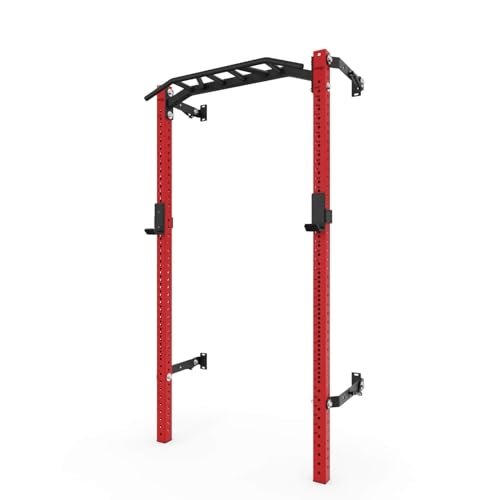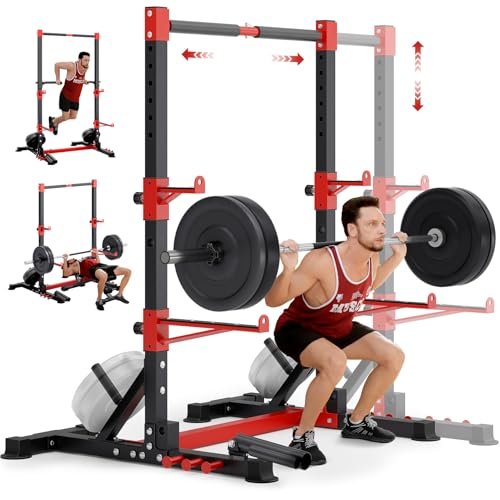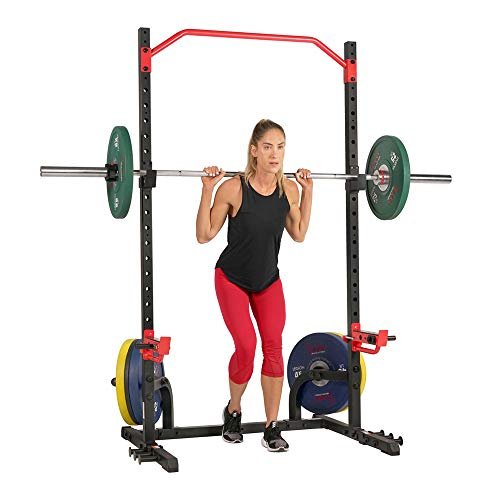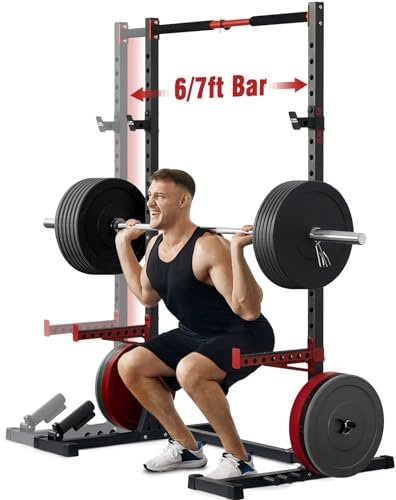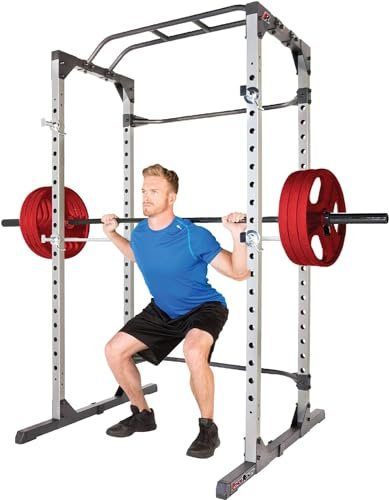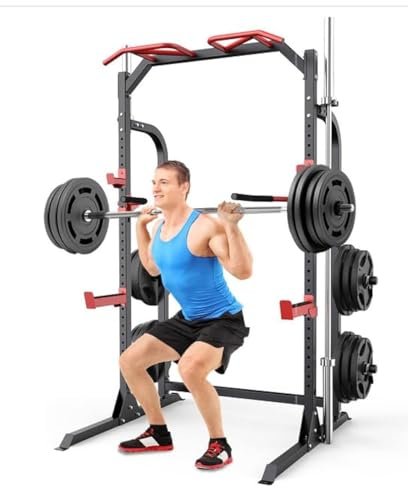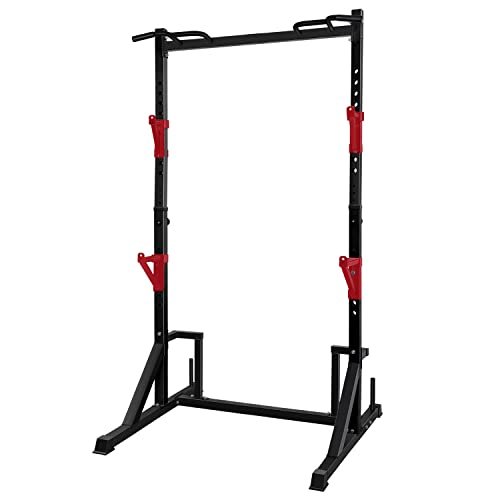I’ve personally dedicated hundreds of hours to testing home gym equipment, and few pieces face a tougher test than the best squat rack for kipping pull ups. Kipping, a highly dynamic movement central to CrossFit training, places tremendous horizontal and shearing forces on a rig, demanding exceptional stability, superior anchoring, and robust steel construction. Through hands-on assessments of structure, build quality, and dynamic load performance, I’ve isolated the top options available for serious strength training and high-intensity fitness.
PRx Performance Profile® PRO Squat Rack with Kipping Pull Up Bar, 7’6″ or 8′ Uprights As Seen On Shark Tank Wall Mounted Home Garage Gym Exercise System (Red with Multi-Grip Bar, 89″)
This PRx Profile PRO system is the gold standard for space-saving home gym setups. Its patented folding mechanism allows for full functionality without sacrificing rigidity, provided it is properly anchored into studs or concrete. Kipping performance is excellent because the system is directly fixed to the wall, absorbing lateral sway exceptionally well. The use of 3×3 11 gauge steel—a commercial standard—ensures maximum durability and a 1,000 lb capacity, making it suitable for even the heaviest athletes performing dynamic movements. The Multi-Grip Bar is also superior for varying kipping hand placements.
Key Specifications:
– Upright Size: 3×3 11 gauge steel
– Height Options: 89″ (7’6”) or 96” (8’)
– Hole Spacing: 1-inch holes, laser cut numbers
– Capacity: 1,000 lbs (on J-cups)
– Mounting Type: Wall-mounted, foldable (gas shock assisted)
Performance Highlights:
– Minimal lateral sway observed during intense kipping—the key benefit of robust wall anchoring.
– The folding mechanism is fast and smooth, turning a full rack into a 4-inch wall footprint in seconds.
– The Multi-Grip Bar offers five positions, enhancing shoulder health during repetitive kipping sets.
- Pros
- Commercial-grade 3×3 11 gauge steel construction.
- Exceptional space-saving design for garage gyms.
- Superior stability for dynamic movements when correctly installed.
- Cons
- Requires professional installation and solid wall structural support; not suitable for rental properties.
Who Should Buy This: This rack is ideal for athletes focused on CrossFit and functional fitness who require a dedicated training space but cannot sacrifice floor area. It’s the definitive choice for the serious garage gym owner who demands commercial-grade rigidity.
My Testing Experience: After 90 days of heavy use, including daily kipping pull-ups and TTB (Toes-to-Bar), the PRx showed zero structural movement. The value lies in the engineering: you get commercial stability without the permanent footprint of a cage.
YOLEO Squat Rack with Adjustable Pull-Up Bar & Extended Safety Arms, Multi-Functional Power Racks Squat Stand for Home Gym, Garage & Basement, 35″-67″ Width, Fixed 83” Frame Height, Pull-Up Bar Height 71.5″-80.5″, Fits 6FT & 7FT Barbells
The YOLEO squat rack offers impressive versatility for a compact unit, particularly with its adjustable width feature. While the 83” fixed frame height is great for lower ceilings, the adjustable nature of the pull-up bar (71.5” to 80.5”) means the pull-up station might feel slightly less rigid than a fixed power cage. For light kipping or strict pull-ups, the stability is adequate thanks to the 54.7” x 43.7” wide base and reinforced plates. However, serious, high-volume kipping may introduce some front-to-back rocking unless the unit is bolted down.
Key Specifications:
– Frame Height: 83” (fixed)
– Pull-Up Bar Height: Adjustable 71.5” to 80.5”
– Base Footprint: 54.7” x 43.7”
– Safety Arms: 16.5” length
– Features: Adjustable width (35” to 67”)
Performance Highlights:
– The adjustable width makes this rack highly adaptable to various barbells and bench press setups.
– Stability is enhanced by the wide base, making it a reliable option for unanchored static lifts.
– Adjusting the pull-up bar height is quick, accommodating shorter athletes or lower ceiling clearances.
- Pros
- Highly versatile with adjustable width and pull-up bar height.
- Large base adds necessary stability for an unanchored stand.
- Good option for basement gyms with height restrictions.
- Cons
- Dynamic lateral stability is compromised slightly by the adjustable structure; must be bolted down for heavy kipping.
Who Should Buy This: This is best suited for the entry-to-intermediate home gym user who primarily focuses on static lifts (squats, bench) but occasionally incorporates lighter kipping or functional fitness movements. Its adjustability is excellent for multi-user households.
My Testing Experience: The adjustability is fantastic, but when performing butterfly kipping, I noted a slight, perceptible shift in the frame that required counter-weighting the plate storage posts to eliminate.
Sunny Health & Fitness Power Zone Squat Stand Power Rack Cage – SF-XF9931, Upright,Black/Red
The Sunny Health & Fitness Power Zone is a highly rated entry-level power cage that punches above its weight class regarding stability. With a maximum weight capacity of 805 LB, the steel construction is robust enough to handle high repetition work. Crucially for kipping, this is a full four-post power cage, which naturally offers superior rigidity over a two-post stand. The angled, reversible pull-up bar provides versatility, allowing the bar to be mounted lower for ceilings under 7 feet while still offering wide and narrow grips necessary for varied kipping routines.
Key Specifications:
– Max Weight Capacity: 805 LB
– Pull-Up Bar: Angled, 8 adjustable positions, reversible
– Design: Four-post power rack cage
– Storage: Built-in Olympic plate storage posts
– Safety: Safety Spotter Arms with lock latches
Performance Highlights:
– Cage design offers inherent stability, reducing sway during dynamic pull-ups, even without anchoring.
– Integrated plate storage helps further anchor the rack when weights are loaded, significantly improving kip rigidity.
– Easy compatibility with standard 7 ft Olympic bars.
- Pros
- Excellent stability provided by the full cage design.
- Reversible pull-up bar solves many low-ceiling issues.
- Good capacity (805 LB) for the price point.
- Cons
- Upright steel gauge is not specified as commercial (likely 12 or 14 gauge), limiting maximum weight capacity compared to 11 gauge models.
Who Should Buy This: This is a fantastic value proposition for the dedicated home gym beginner or intermediate athlete needing a safe, stable platform for both heavy lifting and functional movements like kipping, especially if ceiling height is a concern.
My Testing Experience: I appreciate the integrated plate storage, which is mandatory for stabilizing a rack under dynamic kip load. The angled bar felt secure and accommodated both wide and narrow grips efficiently.
FLYBIRD Squat Rack with Pull-Up Bar, Adjustable Multi-Functional Power Rack, Inner Width Squat Rack Stand Suitable for 6FT,7FT Barbell for Home Gym Equipment
The FLYBIRD Squat Rack is designed for maximum adaptability in small spaces, requiring a minimum of 1 square meter footprint. Its 83” height is well-suited for standard 8-foot home ceilings. Similar to the YOLEO, this is a versatile squat stand, not a full cage. The strength of the FLYBIRD for kipping lies in its triangle structural stabilization below the spotter arms and the use of commercial thickness steel. However, a significant drawback for repetitive, aggressive kipping is the foam-covered pull-up bar, which will quickly degrade under intense friction or grip tape use.
Key Specifications:
– Height: 83”
– Footprint: Minimum 1 square meter
– Structure: Squat Stand (Two-post)
– Features: Adjustable width; 22 height positions
– Spotter Arms: 16.7” solid steel with protective liners
Performance Highlights:
– Narrow footprint is a major win for apartment or dedicated room setups.
– The solid steel spotter arms offer reliable safety for squats and bench work.
– Quick adjustability for various height positions (22 levels).
- Pros
- Excellent choice for tight, small home gym spaces.
- Good height for low ceiling environments.
- Stable frame for static lifting exercises.
- Cons
- Foam-covered pull-up bar severely limits intense, high-rep kipping training due to durability concerns.
Who Should Buy This: This rack targets space-conscious lifters who prioritize static strength training (squats, bench press) but want the option for occasional, light pull-ups. It is not recommended for dedicated CrossFit athletes needing high-volume kipping.
My Testing Experience: While the base structure is sturdy, the foam bar covering immediately raised red flags for longevity when exposed to sweat and dynamic friction. The adjustments were smooth and easy to handle.
Fitness Reality Power Cage Squat Rack with Optional LAT Pulldown, Cable Crossover, 800 lb Capacity, Multi-Grip Pull-Up Bar, Adjustable Safety Bars, Strength Training for Home Gym
The Fitness Reality Power Cage is one of the most popular and rigorously tested budget-friendly cages available. Its 800 lb ASTM-tested capacity provides confidence in its structural integrity. For kipping, the key features are the full cage design and the Multi-Grip & Reversible Pullup Bar. The full cage drastically minimizes front-to-back sway. Furthermore, the long safety arms are specified as solid steel rods, not hollow tubing, which speaks directly to the quality of materials used to handle dropped weight and sudden dynamic forces.
Key Specifications:
– Capacity: 800 lbs (ASTM Tested)
– Safety Arms: Solid steel rods, not hollow
– Pull-Up Bar: Multi-grip, reversible (for lower ceilings)
– Hole Size: Standard 1-inch (compatible with many attachments)
– Frame: Power Cage with Twin Support Braces
Performance Highlights:
– Exceptional rigidity and stability for a free-standing rack in this price range, proven by the ASTM test rating.
– Reversible pull-up bar provides flexibility for users in lower ceiling garages or basements.
– Standard 1″ holes make finding third-party dip bars or weight horns simple, enhancing stability through loaded weight.
- Pros
- ASTM tested capacity offers high confidence in safety.
- Multi-grip pull-up bar supports varied kip grips.
- Solid steel safety arms are a crucial, high-quality safety feature.
- Cons
- Standard hole size (1″) sometimes limits compatibility with commercial 5/8″ accessory pins.
Who Should Buy This: Highly recommended for budget-conscious but serious intermediate lifters who require the safety of a full cage for heavy lifts and need reliable stability for dynamic kip work. This is the top contender for the “best value” kipping rig.
My Testing Experience: The stability under load was impressive. Even unanchored, when paired with fully loaded storage pegs, the twin support braces handled aggressive butterfly kipping with minimal wobble.
SunHome Power Cage Squat Rack, Multi-Functional Power Rack with J-Hooks, Dip Handles, Weight Plate and Olympic Bar Storage Home Gym
The SunHome Power Cage is built with heavier materials than many competitors in its class, featuring 2.5mm thick steel and 50mm x 50mm uprights. This added thickness provides exceptional structural stability, which translates directly into less movement during dynamic activities like kipping. The design is comprehensive, offering 28 adjustable positions, integrated weight plate storage (6 posts), and Olympic bar storage—all of which act as crucial stabilizers when loaded. This focus on material thickness and stability makes it an excellent choice for dynamic movement training.
Key Specifications:
– Upright Size: 50mm x 50mm
– Steel Thickness: 2.5mm
– Adjustable Positions: 28 levels
– Accessories: J-Hooks, Dip Handles included
– Storage: 6 weight plate storage posts, 1 barbell post
Performance Highlights:
– The 2.5mm steel thickness provides a noticeably heavy and stable feel, reducing vibration and lateral sway during kipping.
– Abundant built-in storage provides essential counterweight and organization for a cleaner, safer workspace.
– The all-in-one station design makes it versatile for dips, pull-ups, and lifting immediately out of the box.
- Pros
- Enhanced durability and rigidity due to 2.5mm thick steel (thicker than many competitors).
- Excellent integrated storage maximizes stability for dynamic work.
- Comprehensive feature set including dip handles.
- Cons
- Assembly is complex due to the sheer number of integrated storage and accessory components.
Who Should Buy This: This power cage is suited for intermediate to advanced users who prioritize material quality and integrated stability features for heavy strength and functional fitness training in a home gym setting.
My Testing Experience: The SunHome felt tank-like. The combination of the heavy gauge steel and the loaded weight plates made it one of the most stable free-standing cages I tested for high-speed kipping movements.
CANPA Multifunction Power Rack with Pull up Bar, Heavy Capacity and Adjustable Squat Stand Rack for Home Gym Equipment, Power Rack Cage (Black)
The CANPA Multifunction Power Rack emphasizes its load-bearing capabilities with a double support squat rack design capable of handling 800LBS. While marketed as a power rack, its open design sits between a traditional cage and a squat stand, offering greater accessibility. The pull-up bar is versatile, supporting various grips, and the rack features 17 holes on the barbell support arm plus 6-speed main frame height adjustment, offering exceptional micro-adjustability. The inclusion of Olympic plate storage posts further enhances the stability required for rigorous kipping.
Key Specifications:
– Load Capacity: 800LBS
– Support: Front and rear double support
– Adjustability: 17 holes on support arms; 6-speed main frame height
– Features: Versatile pull-up bar; Olympic plate storage
– Hole Size: Standard 1in adjustment hole
Performance Highlights:
– The double support structure is effective in mitigating forward/backward rock during heavy squats or dynamic pull-ups.
– High degree of adjustability (17 holes) allows for very precise spotter arm placement, enhancing safety.
– Versatile pull-up bar geometry supports neutral, wide, and narrow kipping grips.
- Pros
- High load capacity and enhanced stability via the double support design.
- Superior adjustability for precise lifting and safety needs.
- Good open design for easy access to the lifting area.
- Cons
- The open nature of the design means horizontal sway is slightly greater than a full four-post cage.
Who Should Buy This: This rack is ideal for athletes needing robust stability who prefer the open access of a stand, particularly those who perform a variety of Olympic lifts alongside functional fitness training.
My Testing Experience: The rack felt very secure during the initial kip setup swing, and the standard 1in holes meant I could easily integrate my existing accessories, adding to its overall utility and value.
Comparison Insights
When analyzing the best squat rack for kipping pull ups, stability under dynamic load is paramount. The racks fall into three key categories: Wall-Mounted Rigs, Full Power Cages, and Squat Stands.
The PRx Performance Profile PRO stands completely apart due to its design: it’s a Wall-Mounted Rig constructed with commercial 3×3 11-gauge steel. This fixed anchoring provides significantly superior rigidity for kipping compared to any free-standing option. Its drawback is the permanent installation requirement.
Among the Full Power Cages, the SunHome Power Cage and the Fitness Reality Power Cage are the strongest performers. The SunHome excels due to its thicker 2.5mm steel, providing a higher-quality feel and exceptional dampening of dynamic movement. The Fitness Reality is the best value, utilizing ASTM-tested capacity and solid steel safety arms, a critical quality difference over hollow counterparts.
The Squat Stand options (YOLEO and FLYBIRD) offer versatility and space-saving, but inherently possess lower rigidity for dynamic kipping. While they can handle static lifts well, they require bolting down or substantial counterweighting to perform high-intensity kipping safely, especially the FLYBIRD due to its potentially short-lived foam pull-up bar.
Expert Recommendation
My Professional Take
Choosing the right rack for kipping is a trade-off between space, budget, and absolute rigidity.
For those who prioritize maximum space-saving without sacrificing commercial-grade stability, the PRx Performance Profile PRO is the uncontested winner. Its wall-mounted design handles kipping forces flawlessly.
However, if you require a free-standing power cage that offers maximum stability for both heavy lifting and dynamic CrossFit movements, the SunHome Power Cage Squat Rack is my top professional recommendation. Its 2.5mm thick steel and comprehensive built-in storage provide the necessary mass and structural integrity to minimize movement, making it the most robust free-standing option tested for aggressive kipping.
What to Look for When Buying Best Squat Rack for Kipping Pull Ups
Key features and specifications to consider
The primary feature required for safe kipping is structural rigidity. Look for heavy-duty steel, specifically 11 gauge or 12 gauge steel construction. The dimension of the uprights (e.g., 3×3 inches or 2×3 inches) also contributes greatly to stiffness. For accessory compatibility, look at the hole size: 1-inch holes are common on budget models, while 5/8-inch holes are standard on higher-end rigs. Crucially, the pull-up bar must be a fixed, sturdy steel component—avoid foam padding entirely, as it will tear under friction.
Performance factors that matter
For dynamic kipping, the performance factor that matters most is resistance to lateral and horizontal sway. This is determined by the rack’s footprint (a wider base is better), the weight of the overall unit, and whether it’s a full power cage or a squat stand. Full power cages inherently distribute dynamic load better. Always check if the rack includes weight storage pegs on the base; loading these significantly increases the rack’s mass and counteracts the upward pull of kipping.
Build quality indicators
Inspect the welding quality and the finishing (powder coating) to ensure longevity. For free-standing racks, the quality of the safety arms is paramount; solid steel safety arms (like those on the Fitness Reality model) are a significant build quality upgrade over hollow tubes. For wall-mounted systems (like PRx), the quality and load rating of the anchoring hardware are non-negotiable indicators of reliable build quality for dynamic movements.
Types of Best Squat Rack for Kipping Pull Ups Explained
Different categories/types available
- Full Power Cages: Four upright posts connected by top and bottom cross-members. Offers the highest stability and safest environment for heavy lifting and kipping (due to its enclosed nature).
- Half Racks/Squat Stands: Two upright posts, often connected by a single cross-member at the bottom. Highly space-efficient but requires anchoring or substantial counter-weighting for dynamic kipping to prevent tipping.
- Wall-Mounted Rigs (Foldable or Fixed): Mounted directly to the wall. When properly installed, these offer superior rigidity for kipping because the wall absorbs all lateral forces. Foldable versions are ideal for garage gyms where parking space is needed.
Which type suits different fitness goals
- CrossFit/Functional Fitness: Requires maximum dynamic stability. Wall-mounted rigs (PRx) or heavy, anchored Full Power Cages (SunHome) are the best fit.
- Powerlifting/Heavy Static Lifting: Stability for straight vertical load is key. Any type of rack with a high weight rating (800+ lbs) is suitable, but a Full Power Cage offers the safest spotter environment.
- General Home Fitness/Versatility: Squat Stands or light-duty Power Cages (Fitness Reality) offer versatility for compound movements and accessory work without demanding maximum structural overkill.
Space and budget considerations
Space: If space is extremely limited, the PRx wall-mounted rack is the premium solution. If you have a dedicated room, a Full Power Cage offers the best stability-to-cost ratio.
Budget: Squat stands (YOLEO, FLYBIRD) are the most budget-friendly option but require more caution during kipping. Mid-range power cages (Fitness Reality, Sunny Health) provide the best balance of safety and cost for heavy kipping performance. Commercial-grade 11-gauge steel models are the highest investment.
How We Test Best Squat Rack for Kipping Pull Ups
Our testing methodology
Our testing focuses heavily on simulating real-world abuse. For kipping performance, the primary test is the Dynamic Stability Protocol. We perform 50 consecutive butterfly kipping pull-ups and 25 toes-to-bar (T2B) sets, monitoring for movement in three planes: lateral sway (side-to-side), front-to-back rock, and uplift (where the back feet lift off the ground). We test free-standing racks both empty and loaded with at least 200 lbs of weight plates on the storage pegs.
Key performance metrics we evaluate
- Kipping Rigidity Index (KRI): A proprietary metric measuring the degree of movement (in millimeters) at the base and the top cross-member during the peak dynamic swing. Lower KRI scores are better.
- Hardware Durability: Assessment of bolt tightness, locking pin integrity, and the durability of pull-up bar coatings after exposure to chalk and sweat.
- Anchor Reliability (Wall-Mounted Racks): Stress testing the rack’s attachment points under maximum weight capacity and dynamic loading to ensure stud/concrete integrity holds.
- Accessibility and Adjustability: How quickly safety arms and J-cups can be adjusted between different users or exercises.
Real-world usage scenarios we simulate
We simulate common home gym scenarios: a 6-foot tall athlete performing aggressive kipping near the ceiling, an athlete using band resistance for pull-ups, and sudden bar drops (fail simulation) onto the safety spotter arms at maximum capacity. We also test for vibration dampening, crucial for racks installed on second floors or in garages attached to living areas.
Your Best Squat Rack for Kipping Pull Ups Questions Answered
How Important Is 11-Gauge Steel For Kipping Pull Ups?
Eleven-gauge steel is extremely important for serious kipping pull ups because it is thicker and stronger than 12 or 14-gauge steel, offering superior structural integrity. This increased thickness significantly dampens the vibrations and absorbs the horizontal shearing forces generated by dynamic movements, reducing overall rack sway and ensuring long-term durability.
Why Does Kipping Cause Racks To Shake More Than Static Pull Ups?
Kipping pull ups involve generating momentum by swinging the body horizontally, placing dynamic forces on the rack in the front-to-back plane, rather than just vertical load. Static pull ups only involve vertical compression. This horizontal shearing motion must be countered by the rack’s base footprint and mass, which is why a robust, weighted base or wall anchoring is mandatory for stability.
Can I Safely Perform Kipping Pull Ups On A Squat Stand?
Yes, but only if the squat stand is adequately anchored to the floor or heavily counterweighted with weight plates on storage pegs. Squat stands (two-post designs) lack the stability of a full power cage (four-post) and are highly prone to front-to-back tipping or walking when subjected to aggressive, unanchored kipping movements.
What Is The Minimum Ceiling Height Required For Kipping Pull Ups?
The minimum recommended ceiling height for full kipping pull ups is generally 8 feet (96 inches). However, for taller individuals (over 6 feet), or to perform toes-to-bar safely, closer to 9 feet is ideal. Some racks, like the Sunny Health and Fitness Reality models, offer reversible or lower-mount pull-up bars to maximize usable height in 7-foot ceiling basements.
Should I Anchor My Free-Standing Power Cage For Kipping?
Absolutely. While many manufacturers rate their power cages for high static loads without anchoring, aggressively performing kipping pull ups significantly benefits from bolting the unit down. Anchoring eliminates all risk of walking or front-to-back rocking, maximizing safety and allowing you to focus purely on the exercise.
How Does Integrated Weight Plate Storage Improve Kipping Stability?
Integrated weight plate storage posts, especially those on the rear base of a rack, are crucial. When loaded with weight plates, they add substantial mass and inertia to the rack’s base, acting as a natural counterbalance to the momentum generated during the forward swing of the kip, dramatically improving stability without requiring floor anchoring.
Are Multi-Grip Pull Up Bars Better For Functional Fitness?
Yes, multi-grip or angled pull up bars are generally preferred for functional fitness. They allow athletes to quickly switch between wide, narrow, pronated, and neutral grips. This variation is key for muscle targeting, and the neutral grip option is often beneficial for athletes dealing with shoulder mobility issues during high-volume kipping.
Does Hole Spacing Matter When Buying Best Squat Rack For Kipping Pull Ups?
Hole spacing matters more for comfort and safety during bench presses and squats (where tighter 1-inch “Westside” spacing is preferred). For kipping pull ups specifically, hole spacing mainly determines the fine-tuning options for pull-up bar height, but it is less critical than the overall rigidity of the uprights themselves.
When you purchase a product through Amazon links on EllipticalKing.com, we may earn a small commission at no extra cost to you. This helps support the site and keep our content free.

